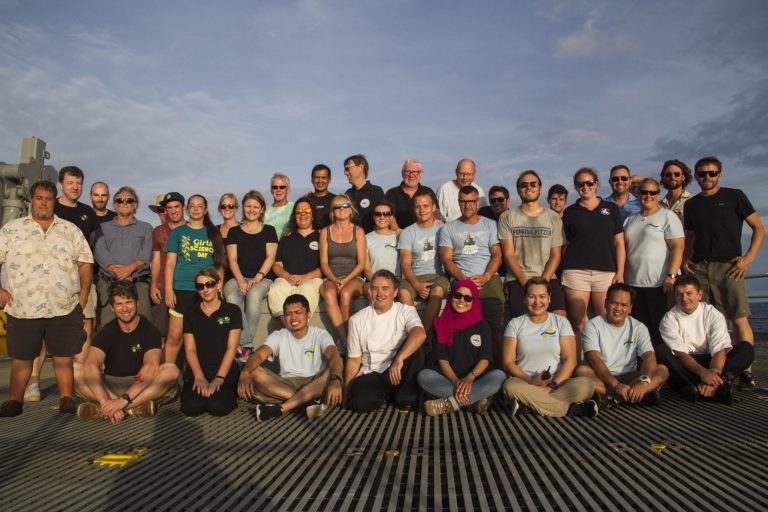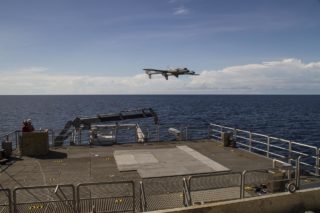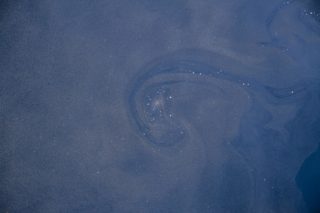Five weeks have gone by since R/V Falkor left from Darwin, Australia sailing out to study the sea surface microlayer: thin as a hair, yet absolutely key for chemical and biological processes affecting the entire planet.
While transiting to Guam, the crew and scientific party are busy demobilizing and packing – getting everything prepared to travel back to home labs, and leaving Falkor ready for its next endeavour. The results of this innovative, collaborative approach will become clearer once the samples are analyzed back ashore, and for the time being the four working groups onboard already have an idea of this expedition’s remarkable accomplishments.

Stronger Together
One of the main objectives of this expedition was bringing together a truly interdisciplinary team that would shed light into an often overlooked component of our global carbon cycle system: the sea surface microlayer (SML). Four scientific teams came together to analyze trace metals, chemistry, biology, physics and gas velocity exchange. This is the first time such an approach has been taken, yet it is not the only way in which this cruise has pushed the envelope. For Chief Scientist Oliver Wurl, all objectives were fully attained: “I cannot remember ever leaving a cruise so happy! To have come here and have done everything we proposed we would do, which is not always easy at sea,” he said.

Unmanned Aerial Vehicles carrying scientific instruments launched from a ship for the first time without the help of a catapult or launching system. It was also the first time the HQ-60B model completed a science mission. The aircrafts completed 15 flights amounting to more than 27 hours of flight.
The remotely operated catamaran scanned the sea surface for over 130 hours and 450 kilometers. Some 400 water samples were taken, to the point that every single bottle the scientific party brought onboard was filled. The drifting buoy gathered 100 gas transfer velocity measurements, and over 500,000 in situ data points were taken. Measurements of the physical processes affecting air-sea exchange add up to around 75 terabytes of information. This is but a fraction of the data collected; it will now be processed in order to explain new aspects about the ocean.
Highlights

Just off the coast of Australia, huge phytoplankton blooms were visible. The experts onboard were amazed to find that the cyanobacteria greatly enriched in the microlayer, as well as recording observations regarding the effect the blooms had in damping the waves and affecting air-sea exchange. The scientists have long known that Trichodesmium have blooms at the surface, but now they know that they are in the microlayer.
This was also the first time that all three microlayer sampling methods (rotating disk, glass plate and quartz tube) have been applied at the same stations for the analysis of organic compounds. The samples taken will show how well the techniques are in accord, providing further information to improve scientific techniques.

The blue copepods found in the microlayer also open new lines of enquiry. Why were they only found at the very surface? The zooplankton was found in widely spaced stations, which means it was not an isolated event, but a feature to be studied in the future. The team also found that the catamaran rotating disk sampling method is able to collect those copepods, while the glass plate and quartz tube samplers scare them away.
For the first time, microlayer samples for trace metals were collected during a rain event while also collecting rainfall and aerosols. Along with this rare and very lucky occurrence, the team was able to conduct kayak sampling before or after the rain events. They are confident that this data will empower them to very accurately quantify aerosol trace element deposition and enrichment in the microlayer.
Why?
It is important to come back to the main question: why should we all be interested in the sea surface microlayer? Simply put, everything that enters the ocean from the atmosphere or exits the ocean to the air must go through the SML, and therefore can be effected by the complex processes taking place inside it. The sea surface microlayer plays a fundamental role in the exchange of greenhouse gases between the atmosphere and the ocean, so understanding the SML is paramount for the creation of trustworthy models to predict climate change. This knowledge will better prepare us for the changes that may take place on the planet we all inhabit.

